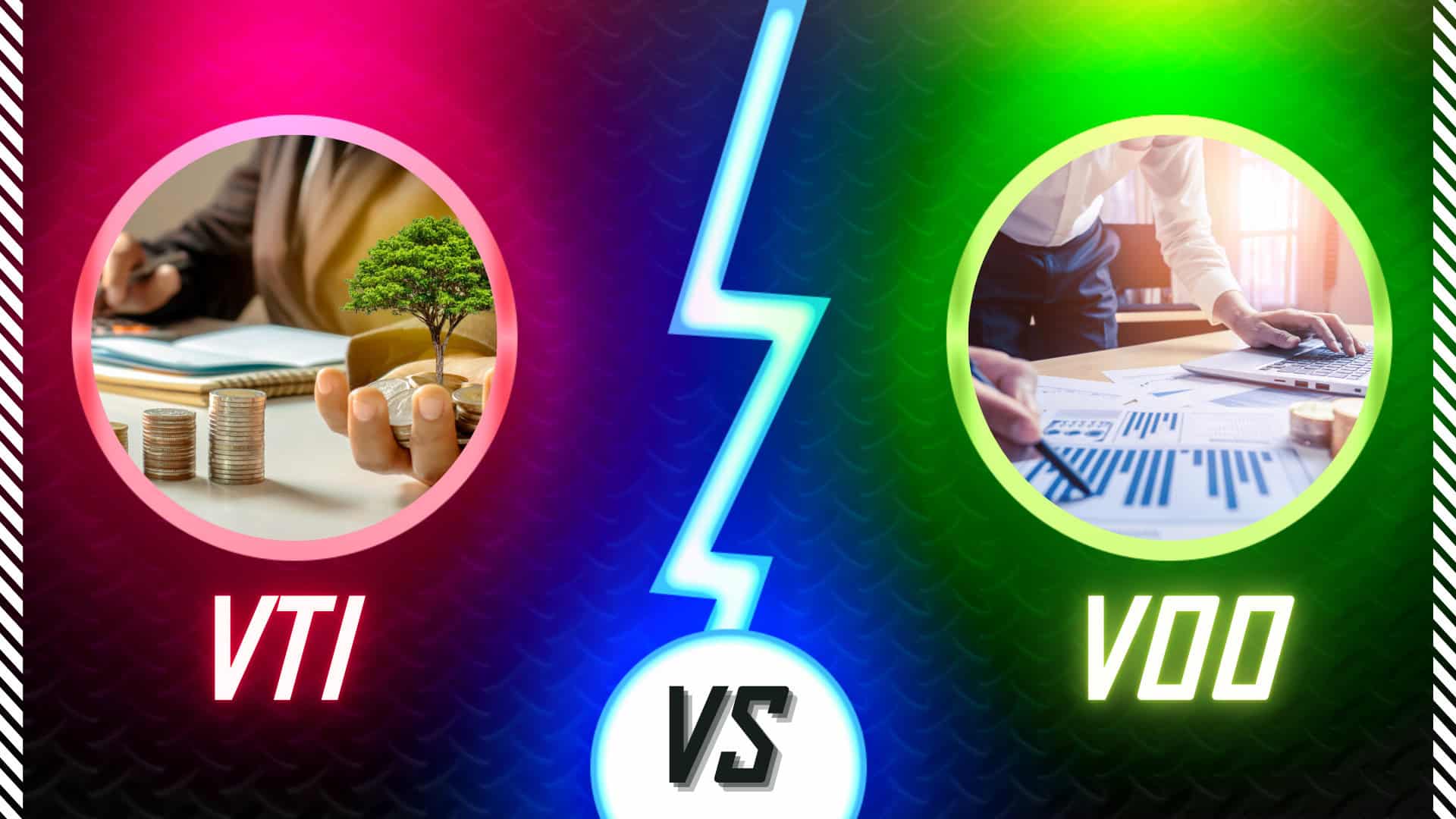
Diversification is key in today’s investing world. Exchange-traded funds, or ETFs, offer a convenient and affordable way to achieve this. Think of them as baskets filled with a variety of stocks. You get to invest in the whole basket at once, allowing you to diversify with a single purchase.
But there are tons of ETFs available. Choosing the right one depends on your investment goals and comfort level with risk. VOO and VTI are both popular choices. While they may look similar, they are quite different.
The choice between VTI and VOO hinges on an investor’s risk tolerance and time horizon. VTI is a better fit for long-term, diversified growth due to its broad market coverage of all US stocks, including large, mid, small and micro-cap stocks. On the other hand, VOO appeals to those prioritizing shorter-term stability and established companies, as it focuses on the largest U.S. companies within the S&P 500. We’ll take a deeper look at these two ETFs below.
What is VOO?

The Vanguard S&P 500 ETF (NYSE: VOO) tracks the performance of the S&P 500, a widely recognized benchmark for the US stock market. The S&P 500 itself represents the 500 largest publicly traded companies in the US.
By investing in VOO, you’re essentially investing in the top 500 publicly traded US companies. These large-cap companies have tons of stability and a proven track record. Otherwise, they wouldn’t be one of the top 500 companies!
Many of these companies also pay out dividends, which is an added bonus. VOO boasts a very low expense ratio, meaning the fees associated with owning the ETF are minimal.
VFAIX is very similar to VOO, as it tracks the S&P 500. If you’re interested in comparing these two stocks, we have an article on VFAIX vs. VOO.
What is VTI?

Vanguard Total Stock Market ETF (NYSE: VTI) takes a different approach. Instead of focusing on the biggest players, VTI tracks the CRSP US Total Stock Market Index. This index encompasses a wider range of US companies. Some are the same companies VOO tracks, while others are up-and-coming small-cap stocks.
VTI provides extreme diversification. This means your holdings aren’t as heavily reliant on the performance of just a few larger companies.
The goal of VTI is to mirror the performance of the entire US stock market. It offers the potential for long-term growth that reflects the health of the US economy. Just like VOO, it also has a low expense ratio, helping keep your investment costs down.
VOO vs. VTI: Which Fund is Right for You?

These two funds are vastly different. Let’s take a look at some of the most extreme differences.
Fees and Risks
Before discussing performance, let’s consider each ETF’s financial aspects. Both VOO and VTI boast very low expense ratios. This ratio is an annual fee charged by the ETF for management purposes.
Lower expense ratios translate to more money going toward your investment and less toward fees. Both of these ETFs are budget-friendly options.
Now, let’s talk about risk. One way to measure risk is through the Beta. Beta is the volatility of an investment compared to the overall stock market. The base volatility of the market is 1. So, the further a stock’s Beta moves away from 1, the more or less volatile it is.
A Beta higher than one suggests the investment is more volatile than the market, while a Beta under one implies the investment is less volatile.
VTI’s price swings a bit more than VOO’s, as it contains small-cap stocks that tend to fluctuate more. However, this difference is very slight. Overall, these stocks are very similar in terms of fluctuations. Currently, VOO’s Beta is 1.0, while VTI’s Beta 1.01. That’s not a huge difference.
Historical Performance
While past performance is never a crystal ball for future results, it can offer some insights. Historically, VOO might have a slight edge in terms of returns. This isn’t surprising considering its focus on large-cap companies. These established players tend to deliver steadier, albeit sometimes less explosive, growth.
However, VTI includes small to mid-cap stocks alongside large-cap, offering the potential for higher long-term growth. Broad exposure does come with the potential for more volatility, as smaller companies are more sensitive to market swings.
Here’s a chart comparing the returns of each ETF:
| Timeframe | VOO Return | VTI Return |
| Month-end | 2.39% | 2.13% |
| 1 Year | 27.00% | 26.16% |
| 5 Years | 15.88% | 15.12% |
| 10 Years | 12.94% | 12.31% |
Top Holdings
Looking at the specific holdings can offer further insight into each ETF. VOO, with its focus on large-cap stability, will unsurprisingly have established giants like Apple, Microsoft, and Amazon at the top of its list. These companies are known for their strong track records and tend to be major players in the market.
Here are VOO’s current top holdings:
- Apple Inc. (AAPL)
- Microsoft Corp. (MSFT)
- NVIDIA Corp. (NVDA)
- Amazon.com Inc. (AMZN)
- Meta Platforms Inc. (META)
- Alphabet Inc. Class A (GOOGL)
- Berkshire Hathaway Inc. Class B (BRK.B)
- Alphabet Inc. Class C (GOOG)
- Eli Lilly & Co. (LLY)
- Broadcom Inc. (AVGO)
VTI, on the other hand, has a slightly different style. As we’ve discussed, it emphasizes diversification. This translates to a wider range of holdings. While you’ll find many of the same large-cap companies present in VOO, VTI also ventures into smaller and mid-cap companies across various sectors.
Here are VTI’s current top holdings:
- Apple Inc. (AAPL)
- Microsoft Corp. (MSFT)
- NVIDIA Corp. (NVDA)
- Amazon.com Inc. (AMZN)
- Meta Platforms Inc. (META)
- Alphabet Inc. Class A (GOOGL)
- Berkshire Hathaway Inc. Class B (BRK.B)
- Eli Lilly & Co. (LLY)
- Alphabet Inc. Class C (GOOG)
- Broadcom Inc. (AVGO)
While the top ten holdings of these ETFs are basically the same, the percentage that each company makes up varies. For instance, Microsoft is 6.95% of VOO’s assets, but it makes up 6.06% of VTI’s. That’s where the difference comes in!
The Bottom Line

Ultimately, choosing VOO or VTI hinges on your investment goals and risk tolerance.
Looking for stability and established companies? VOO, with its concentration on large-cap companies, might be a good fit. Its lower volatility leads to less explosive drops or growth.
Prioritizing diversification? VTI has a broader exposure to the US market spectrum and may be more appealing. While it might experience more volatility due to the inclusion of smaller companies, VTI also offers the potential for higher returns over the long term.
100 Million Americans Are Missing This Crucial Retirement Tool
The thought of burdening your family with a financial disaster is most Americans’ nightmare. However, recent studies show that over 100 million Americans still don’t have proper life insurance in the event they pass away.
Life insurance can bring peace of mind – ensuring your loved ones are safeguarded against unforeseen expenses and debts. With premiums often lower than expected and a variety of plans tailored to different life stages and health conditions, securing a policy is more accessible than ever.
A quick, no-obligation quote can provide valuable insight into what’s available and what might best suit your family’s needs. Life insurance is a simple step you can take today to help secure peace of mind for your loved ones tomorrow.
Click here to learn how to get a quote in just a few minutes.
Thank you for reading! Have some feedback for us?
Contact the 24/7 Wall St. editorial team.





